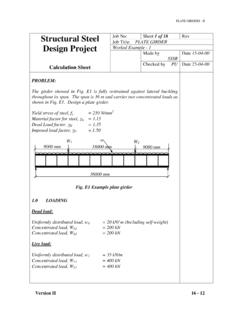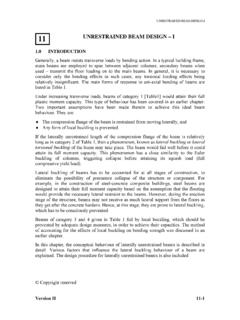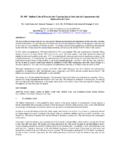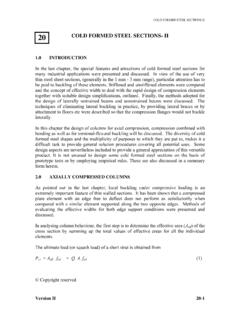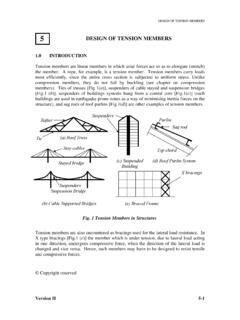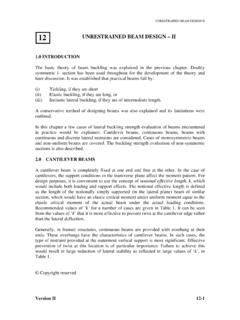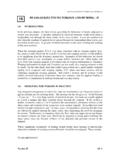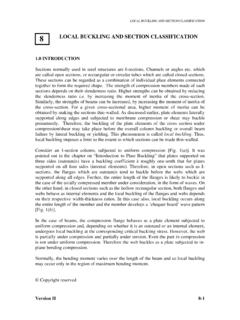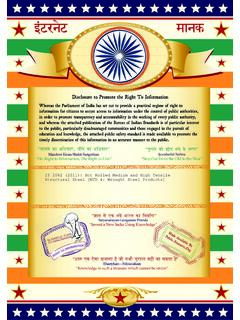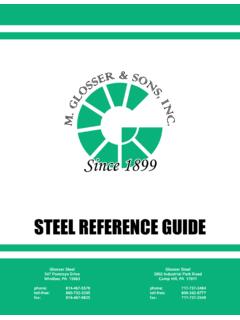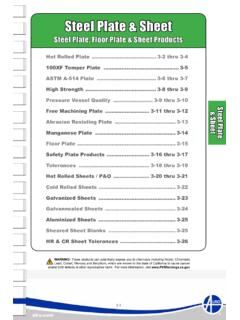Transcription of 19 COLD FORMED STEEL SECTIONS – I
1 COLD FORMED STEEL SECTIONS -I COLD FORMED STEEL SECTIONS I 19 INTRODUCTION Thin sheet STEEL products are extensively used in building industry, and range from purlins to roof sheeting and floor decking. Generally these are available for use as basic building elements for assembly at site or as prefabricated frames or panels. These thin STEEL SECTIONS are cold- FORMED , their manufacturing process involves forming STEEL SECTIONS in a cold state ( without application of heat) from STEEL sheets of uniform thickness. These are given the generic title Cold FORMED STEEL SECTIONS .
2 Sometimes they are also called Light Gauge STEEL SECTIONS or Cold rolled STEEL SECTIONS . The thickness of STEEL sheet used in cold FORMED construction is usually 1 to 3 mm. Much thicker material up to 8 mm can be FORMED if pre-galvanised material is not required for the particular application. The method of manufacturing is important as it differentiates these products from hot rolled STEEL SECTIONS . Normally, the yield strength of STEEL sheets used in cold- FORMED SECTIONS is at least 280 N/mm2, although there is a trend to use steels of higher strengths, and sometimes as low as 230 N/mm2. Manufacturers of cold FORMED STEEL SECTIONS purchase STEEL coils of to m width, slit them longitudinally to the correct width appropriate to the section required and then feed them into a series of roll forms.
3 These rolls, containing male and female dies, are arranged in pairs, moving in opposite direction so that as the sheet is fed through them its shape is gradually altered to the required profile. The number of pairs of rolls (called stages) depends on the complexity of the cross sectional shape and varies from 5 to 15. At the end of the rolling stage a flying shearing machine cuts the member into the desired lengths. An alternative method of forming is by press - braking which is limited to short lengths of around 6 m and for relatively simple shapes. In this process short lengths of strip are pressed between a male and a female die to fabricate, one fold at a time and obtain the final required shape of the section.
4 Cold rolling is used when large volume of long products are required and press breaking is used when small volume of short length products are produced. Galvanizing (or zinc coating) of the preformed coil provides very satisfactory protection against corrosion in internal environments. A coating of 275 g/m2 (total for both faces) is the usual standard for internal environments. This corresponds to zinc coating of mm. Thicker coatings are essential when moisture is present for long periods of time. Other than galvanising, different methods of pre-rolling and post-rolling corrosion protection measures are also used.
5 Copyright reserved Version II 19-1 COLD FORMED STEEL SECTIONS -I Although the cold rolled products were developed during the First World War, their extensive use worldwide has grown only during the last 20 years because of their versatility and suitability for a range of lighter load bearing applications. Thus the wide range of available products has extended their use to primary beams, floor units, roof trusses and building frames. Indeed it is difficult to think of any industry in which Cold rolled STEEL products do not exist in one form or the other. Besides building industry, they are employed in motor vehicles, railways, aircrafts, ships, agricultural machinery, electrical equipment, storage racks, house hold appliances and so on.
6 In recent years, with the evolution of attractive coatings and the distinctive profiles that can be manufactured, cold FORMED STEEL construction has been used for highly pleasing designs in practically every sector of building construction. In this chapter, the background theory governing the design of cold FORMED STEEL elements is presented in a summary form. Design of cold FORMED STEEL SECTIONS are dealt with in IS: 801-1975 which is currently due under revision. In the absence of a suitable Limit State Code in India, the Code of Practice for Cold FORMED SECTIONS in use in the (BS 5950, Part 5 ) is employed for illustrating the concepts with suitable modifications appropriate to Indian conditions.
7 ADVANTAGES OF COLD FORMED SECTIONS Cold forming has the effect of increasing the yield strength of STEEL , the increase being the consequence of cold working well into the strain-hardening range. These increases are predominant in zones where the metal is bent by folding. The effect of cold working is thus to enhance the mean yield stress by 15% - 30%. For purposes of design, the yield stress may be regarded as having been enhanced by a minimum of 15%. Some of the main advantages of cold rolled SECTIONS , as compared with their hot- rolled counterparts are as follows: Cross sectional shapes are FORMED to close tolerances and these can be consistently repeated for as long as required.
8 Cold rolling can be employed to produce almost any desired shape to any desired length. Pre-galvanised or pre-coated metals can be FORMED , so that high resistance to corrosion, besides an attractive surface finish, can be achieved. All conventional jointing methods, ( riveting, bolting, welding and adhesives) can be employed. High strength to weight ratio is achieved in cold- rolled products. They are usually light making it easy to transport and erect. It is possible to displace the material far away from the neutral axis in order to enhance the load carrying capacity (particularly in beams). Version II 19-2 COLD FORMED STEEL SECTIONS -I There is almost no limit to the type of cross section that can be FORMED .
9 Some typical cold FORMED section profiles are sketched in In Table 1 hot rolled and cold FORMED channel section properties having the same area of cross section are shown. From Table 1, it is obvious that thinner the section walls, the larger will be the corresponding moment of inertia values (Ixx and Iyy) and hence capable of resisting greater bending moments. The consequent reduction in the weight of STEEL in general applications produces economies both in STEEL costs as well as in the costs of handling transportation and erection. This, indeed, is one of the main reasons for the popularity and the consequent growth in the use of cold rolled STEEL .
10 Also cold form STEEL is protected against corrosion by proper galvanising or powder coating in the factory itself. Usually a thickness limitation is also imposed, for components like lipped channels. Fig. 1 Typical Cold FORMED STEEL Profiles Table - 1 Comparison of hot rolled and Cold rolled SECTIONS Cold rolled channel3 mm mm Cold rolled channel Cold rolled channel 5 mm 50 100 5 hot rolled channel A 1193 mm21193 mm21193 mm21193 mm2 Ixx 106 106 106 106 mm4 Zxx 38 103 103 103 mm3112 103 mm3 Iyy 106 106 106 106 mm4 Zyy 103 103 mm322 103 mm3 103 mm3 Version II 19-3 COLD FORMED STEEL SECTIONS -I While the strength to weight ratios obtained by using thinner material are significantly higher.
